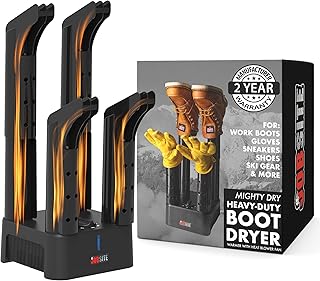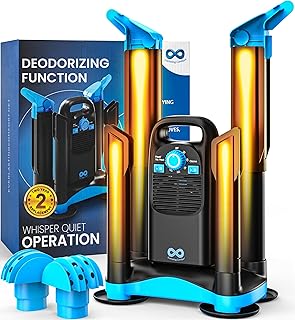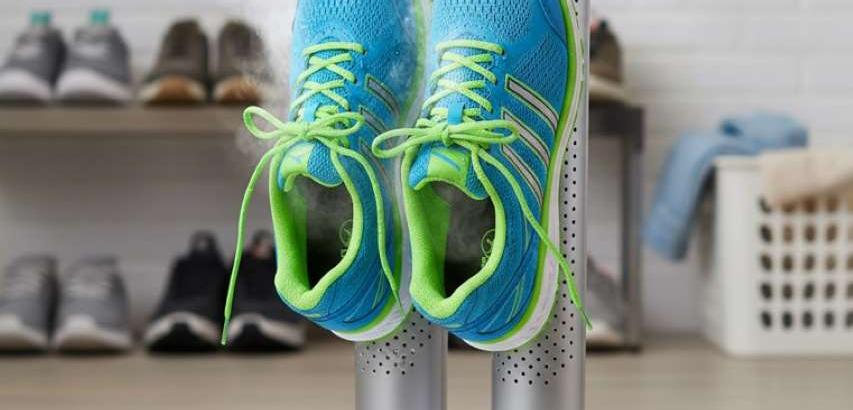An Electric Shoe Dryer is a specialized household appliance designed to dry the interior of footwear efficiently, safely, and effectively. It goes beyond simply evaporating moisture; it is a key tool for maintaining foot health, prolonging the life of shoes, and eliminating the primary cause of foot and shoe odor.
Core Principle and How It Works
The fundamental principle is forced-air circulation combined with gentle, consistent heat.
Gentle Heat: The device uses a low-wattage heating element (typically 20-50 watts) to produce warm—not hot—air. The temperature is carefully controlled to be safe for all shoe materials, including delicate leathers, synthetics, and glues, preventing damage like warping, cracking, or separation of soles.
Airflow: A small, quiet fan forces this warm air through flexible tubes or nozzles that are inserted into the shoe.
Evaporation and Circulation: The warm air circulates throughout the damp interior of the shoe, accelerating the evaporation of moisture from the lining, insole, and padding. The continuous airflow then carries the moist air out of the shoe, replacing it with new, dry, warm air in a constant cycle.
This process is far more effective than ambient air drying, which can leave shoes damp for hours or even days, creating a breeding ground for bacteria and mildew.
Key Components and Features
Heating Element & Fan:
Located in the main base unit. Modern models use PTC (Positive Temperature Coefficient) ceramic heating elements, which are self-regulating and energy-efficient, reducing fire risk.
The fan is designed for quiet operation, making it suitable for use in bedrooms or closets overnight.
Drying Nozzles (Tubes or Wands):
These are the parts inserted into the shoes. They are typically made of flexible, heat-resistant plastic.
Most dryers have multiple nozzles (commonly 2 or 4 pairs) to dry several shoes simultaneously.
Some models feature adjustable nozzles to accommodate different shoe sizes and styles, from children's sneakers to tall winter boots.
Control System:
Basic Models: A simple on/off switch.
Advanced Models: Feature digital timers (e.g., 30-minute to 8-hour settings), adjustable heat settings (low/medium/high), and even a dedicated "cold air" setting for delicate materials or for simply freshening shoes without heat.
Construction and Safety:
The base is stable and weighted to prevent tipping.
Built-in overheat protection is a standard and critical safety feature.
Energy consumption is very low, comparable to a small light bulb.
Types of Electric Shoe Dryers
Standard Multi-Pair Dryers: The most common type, featuring a central base with 2 or 4 flexible nozzles. Ideal for families or individuals with multiple pairs of active footwear.
Boot Dryers: Specifically designed with taller, more rigid wands to channel air to the toe of tall boots, such as hiking, hunting, skiing, or work boots.
Portable/Travel Dryers: Compact, lightweight units, often powered via a USB connection, designed for people on the go.
Shoe Dryer Cabinets: Larger, freestanding cabinets that can dry several pairs of shoes at once, often used in ski lodges, fire stations, or by serious outdoor enthusiasts.
Advantages and Benefits
Eliminates Odor at the Source: Odor is caused by bacteria that thrive in dark, damp environments. By thoroughly drying shoes, the dryer eliminates the conditions necessary for bacterial growth.
Prolongs Shoe Lifespan: Persistent moisture breaks down interior cushioning, causes insoles to deteriorate, and promotes the growth of mold and mildew that can degrade fabrics and leather. Regular drying preserves the shoe's structure and materials.
Promotes Foot Health: Damp shoes can lead to fungal infections like athlete's foot, blisters, and general discomfort. Wearing dry shoes is a fundamental aspect of foot hygiene.
Convenience and Comfort: No more putting on cold, clammy shoes in the morning. It ensures shoes are warm, dry, and comfortable for the next use, regardless of the weather.
Versatility: While designed for shoes, the nozzles can often be used to dry and warm gloves, mittens, and small items of clothing like socks.
Limitations and Considerations
Not a Washer: It does not clean shoes; it only dries and deodorizes them. Dirt and salt stains should be cleaned off first to prevent them from being baked into the material.
Drying Time: Drying time varies based on how saturated the shoes are, their material, and the dryer's power. It typically takes 1 to 4 hours for a thorough dry.
Initial Cost: A quality dryer requires an upfront investment, though it is often offset by the extended life of expensive footwear.
Space: The unit requires a small amount of floor or shelf space for storage and use.
Common Applications and Use Cases
Athletes & Gym-Goers: For drying sweaty running shoes, cleats, and trainers.
Outdoor Enthusiasts: Essential for hikers, skiers, hunters, and cyclists whose footwear gets wet from weather or perspiration.
Workers in Demanding Environments: Construction workers, farmers, firefighters, and medical staff who are on their feet for long hours.
Families with Children: For drying shoes after play, sports, or splashing in puddles.
Anyone Living in a Humid or Rainy Climate: A practical solution for a recurring problem.
An Electric Shoe Dryer is a simple yet profoundly effective appliance that solves a common and often overlooked problem. It transcends the basic function of drying by acting as a vital tool for hygiene, comfort, and footwear preservation. For anyone who leads an active lifestyle, works outdoors, or simply wants to protect their investment in quality footwear, a shoe dryer is a small, intelligent, and highly worthwhile investment that pays for itself in daily comfort and the extended life of your shoes.
 |  |  |
 |  |  |
